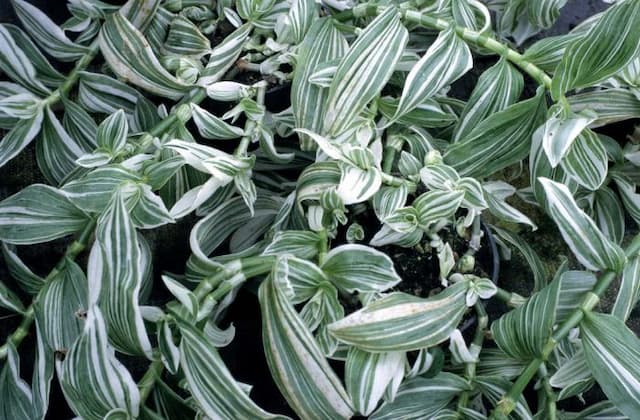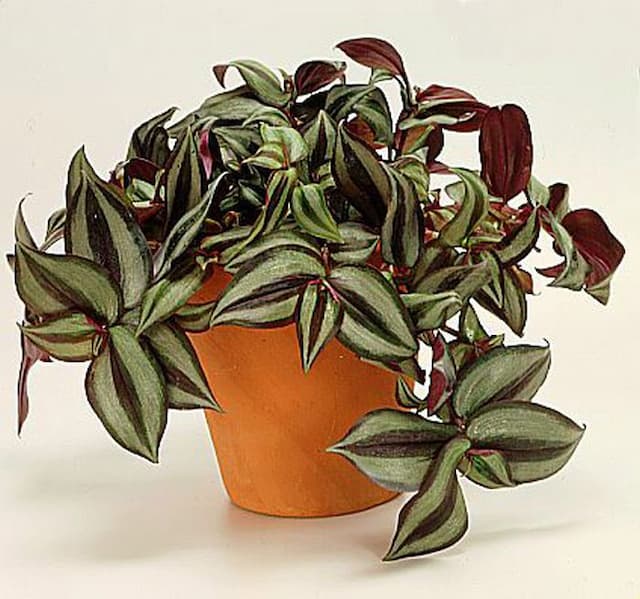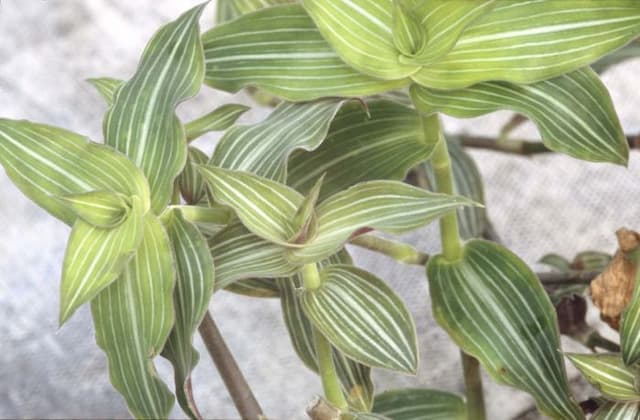Spiderwort Tradescantia (Andersoniana Group) 'J.c. Weguelin'

ABOUT
The Tradescantia 'J.C. Weguelin', often referred to simply as Spiderwort, presents itself with a lush and verdant charm. The plant displays long, slender leaves that gracefully arch and intersect, creating a loosely organized, grass-like effect. These leaves exhibit a rich green color, which forms a perfect backdrop for the flowers. The flowers are perhaps the most striking feature of this Spiderwort, occurring in small clusters. Each individual blossom is relatively modest in size, showcasing a trio of delicate petals. The petals radiate outwards from the center of the flower and are typically a deep, vivid purple or blue, occasionally graced with subtle stripes or variations in hue. The center of the flower is highlighted by a cluster of yellow stamens, a sharp contrast that adds a touch of brightness and attracts the eye. Blooming over an extended period, this Spiderwort's flowers provide a continuous display of color. The overall effect of the plant is one of casual elegance, with its grassy foliage and jewel-toned flowers combining to create an eye-catching and soothing presence in the garden setting.
About this plant
 Names
NamesFamily
Commelinaceae
Synonyms
Spider Lily, Spiderwort
Common names
Tradescantia x andersoniana 'J.C. Weguelin'
 Toxicity
ToxicityTo humans
The Spiderwort, which is the common name for Tradescantia (Andersoniana Group) 'J.c. Weguelin', is generally considered non-toxic to humans. It does not typically cause serious harm if ingested. However, as with any plant, individual sensitivities can vary, and it may cause mild gastrointestinal upset or skin irritation in some people. It's always advisable to avoid eating ornamental plants, as their culinary safety is not guaranteed.
To pets
The Spiderwort, the common name for Tradescantia (Andersoniana Group) 'J.c. Weguelin', is also typically non-toxic to pets such as dogs and cats. It is not known to cause serious illness if pets consume it. Nevertheless, some animals might experience minor symptoms such as vomiting or diarrhea due to individual sensitivities or as a reaction to eating non-food items. As with humans, it's best to prevent pets from ingesting ornamental plants to avoid any potential issues.
 Characteristics
CharacteristicsLife cycle
Perennials
Foliage type
Deciduous
Color of leaves
Green
Flower color
Blue
Height
1-2 feet (0.3-0.6 meters)
Spread
1-2 feet (0.3-0.6 meters)
Plant type
Herb
Hardiness zones
4-9
Native area
North America
Benefits
 General Benefits
General Benefits- Ornamental Aesthetics: The Tradescantia (Andersoniana Group) 'J.C. Weguelin', commonly known as Spiderwort, features attractive flowers that add color and beauty to garden settings.
- Easy to Grow: Spiderwort is known for being easy to care for, making it suitable for both novice and experienced gardeners.
- Drought Tolerance: Once established, the plant has a degree of drought resistance, reducing the need for frequent watering.
- Pest Resilience: Spiderwort generally has good resistance to pests, meaning it requires less chemical intervention to maintain.
- Wildlife Attraction: The plant's flowers can attract pollinators like bees and butterflies, promoting biodiversity in the garden.
- Ground Cover: Spiderwort can be used for ground cover due to its spreading habit, which helps control erosion and suppresses weed growth.
- Shade Tolerance: This plant is capable of growing in partial shade, providing flexibility in garden design and plant placement.
 Medical Properties
Medical PropertiesThis plant is not used for medical purposes.
 Air-purifying Qualities
Air-purifying QualitiesThis plant is not specifically known for air purifying qualities.
 Other Uses
Other Uses- Photography: Tradescantia, due to their vivid colors and unique patterns, can serve as great subjects for macro and nature photography, helping enthusiasts to practice their photography skills.
- Education: These plants can be used in schools and educational programs to teach students about plant biology, cultivation, and the importance of biodiversity in ecosystems.
- Artistic Inspiration: The striking appearance of Tradescantia can inspire artists and crafters in creating paintings, drawings, and textiles.
- Biological Indicator: Tradescantia can be used as an indicator species to study the effect of different environmental conditions like radiation and pollution on plant growth.
- Erosion Control: Due to their fast growth and spreading habit, Tradescantia can be planted in areas prone to soil erosion to help stabilize the soil.
- Bioindication: Some species of Tradescantia are sensitive to changes in the atmosphere, making them useful for indicating air quality in certain regions.
- Fairy Gardens: Their small size and colorful leaves make Tradescantia an excellent choice for creating whimsical fairy gardens.
- Living Mulch: The dense foliage of Tradescantia can be used as a living mulch to retain soil moisture and suppress weeds in garden beds.
- Privacy Screens: In areas where they grow profusely, Tradescantia can be planted to form low hedges or privacy screens in garden settings.
- Culinary Decoration: Although not for consumption, the colorful leaves of some Tradescantia species can be used to add aesthetic value to culinary presentations.
Interesting Facts
 Feng Shui
Feng ShuiThe Spiderwort is not used in Feng Shui practice.
 Zodiac Sign Compitability
Zodiac Sign CompitabilityThe Spiderwort is not used in astrology practice.
 Plant Symbolism
Plant Symbolism- Transience: Tradescantia, also known as Spiderwort, often symbolizes the ephemeral nature of life due to its flowers that tend to last for only one day.
- Adaptability: Spiderwort has a hardy nature, symbolizing the ability to adapt and thrive in various conditions, much like the plant's ease at growing in different environments.
- Resourcefulness: The ease with which Spiderwort propagates symbolizes resourcefulness, as the plant can regenerate from small cuttings and continue to spread.
 Water
WaterSpiderwort should be watered regularly, aiming to keep the soil consistently moist but not saturated. Typically, watering once a week should suffice, but this can vary depending on environmental conditions. During the growing season in spring and summer, you might find the need to water more frequently, possibly twice a week if the weather is particularly hot or dry. Use a watering can or hose to gently water the soil at the base of the plant until the water begins to drain through the bottom of the pot, ensuring you're providing about 1-2 gallons depending on the size of your plant and pot. Cut back on watering in the fall and winter when the plant's growth slows down.
 Light
LightSpiderwort thrives in bright, indirect light but can also tolerate part sun. It is best placed in a spot where it receives morning light and is shielded from the intense sun in the afternoon, as too much direct sunlight can scorch the leaves. An east or north-facing window is ideal for indoor spiderworts, or if it's planted outdoors, a spot with filtered sunlight or partial shade will suit it well.
 Temperature
TemperatureSpiderwort prefers temperature conditions between 50°F and 75°F, which are generally within the typical range of household temperatures. It can handle occasional dips down to about 40°F but not for prolonged periods. Extreme cold or temperatures below 35°F can be detrimental to the plant. It is important to protect spiderwort from frost and to avoid sudden temperature changes which can cause stress to the plant.
 Pruning
PruningSpiderwort benefits from pruning to encourage bushier growth and to remove any faded or dead flowers, leaves, and stems. It's best to prune in the spring as new growth starts to appear. Simply use clean, sharp scissors to cut back any yellowing leaves or stems, and pinch off the tips to promote fuller growth. Pruning can be done every few weeks during the active growth period to maintain its shape and size.
 Cleaning
CleaningAs needed
 Soil
SoilSpiderwort thrives best in a well-draining, loamy potting mix with a slightly acidic to neutral pH of about 6.0 to 7.0. Amending the soil with peat, compost, or perlite can enhance drainage and aeration.
 Repotting
RepottingSpiderwort should be repotted every two years or when it becomes root-bound, to provide fresh nutrients and encourage growth.
 Humidity & Misting
Humidity & MistingSpiderwort prefers moderate humidity levels but is quite adaptable. Aim to maintain humidity around 40-50% for optimal growth.
 Suitable locations
Suitable locationsIndoor
Place in bright, indirect light and keep soil moist.
Outdoor
Grow in partial shade; water regularly but don't overwater.
Hardiness zone
Spiderwort is suitable for 4-9 USDA.
 Life cycle
Life cycleTradescantia (Andersoniana Group) 'J.C. Weguelin', often known as the Spiderwort, begins its life cycle as a seed, which upon finding suitable conditions, germinates to produce a small seedling. The seedling then develops roots and shoots, growing into a vegetative state where it forms clumps of lance-shaped leaves and starts to spread through rhizomes and stolons. As it matures, the plant produces distinctive three-petaled flowers, usually in shades of blue to purple, which bloom in the morning and close by the afternoon. After pollination, which is often aided by bees and other insects, seed capsules form, eventually drying and releasing seeds to complete the reproductive cycle. Spiderwort is a perennial, which means it can live for several years, dying back to the ground in winter and regrowing from its root system in the spring. Propagation can also be achieved through division of its clumps, facilitating a quicker full life cycle in comparison to starting from seed.
 Propogation
PropogationPropogation time
Spring-Early Summer
The Tradescantia (Andersoniana Group) 'J.C. Weguelin', commonly referred to as Spiderwort, can be easily propagated by division, which is the most popular method. This is best done in the spring or early summer when the plant's growth is most active. To propagate by division, gently lift the plant from the ground and separate clumps of stems with roots attached, ensuring each new section has a good amount of roots. These divisions can then be immediately replanted into well-draining soil, spaced about 12 to 18 inches (approximately 30 to 45 centimeters) apart to allow room for growth. Water the new plantings thoroughly to help establish them. This simple process allows gardeners to create new plants that are genetically identical to the parent, ensuring the same flower color and growth habits.



